More Leaves from ‘Otto Ege Manuscript 51’
August 10, 2016 in Manuscript Studies, Photographic Exhibition
Detached Leaves from Otto Ege’s
Erfurt Manuscript of
Aristotle’s Nichomachean Ethics
in Latin Translation on Paper
 Continuing our series on Manuscript Studies, Mildred Budny newly identifies 2 detached leaves, in separate collections, from a paper manuscript dispersed by Otto F. Ege (1888–1951). Containing parts of the text of Aristotle’s Nichomachean Ethics in medieval Latin translation, the leaves formerly belonged to a copy prepared at Erfurt in Thuringia in Germany, and dated by colophon to 1365 C.E.
Continuing our series on Manuscript Studies, Mildred Budny newly identifies 2 detached leaves, in separate collections, from a paper manuscript dispersed by Otto F. Ege (1888–1951). Containing parts of the text of Aristotle’s Nichomachean Ethics in medieval Latin translation, the leaves formerly belonged to a copy prepared at Erfurt in Thuringia in Germany, and dated by colophon to 1365 C.E.
Detached leaves from this book were distributed, in part, through one or another of Ege’s series of Portfolio editions of individual specimen leaves extracted from manuscripts and printed books. Earlier blogposts have examined cases from Ege’s Portfolios of Fifty Original Leaves (1930–1950) and Famous Bibles (1938 and 1949). They report the discoveries of a New Leaf respectively from Ege Manuscript 41, from Ege Manuscript 8, from Ege Manuscript 61, and from Ege Manuscript 14. Now it is the turn of “Ege Manuscript 51” and the Portfolios of Original Leaves from Famous Books (1923 and 1949), in which its Aristotelian specimens normally appeared as their Leaf Number 2.
[Posted on 10 August 2016, with updates provided generously right away by our Associates Lisa Fagin Davis and Linde M. Brocato:
1. Lisa reports the survival now at Yale University of more leaves from the manuscript.
2. Linde — our guestblogger for a recent post (Lillian Vail Dymond) and our consultant for a report in preparation (“Another Manuscript of Juan de Mena’s Laberinto da Fortuna”) — reminds me of the processes of gathering materials to open a medieval university and to stock its library, as well as to supply the needs of its teachers and students. Also, visiting Rhodes College in order to inspect its leaf, she reports observations which the online images do not show so clearly.
And now with more updates from information and images provided generously by Amanda Faehnel and Kathleen Medicus of the Kent State University Libraries Special Collections. Also with images reproduced with permission from The British Library.
More updates to come soon, now that (October 2016) I have seen more leaves from the manuscript and other related materials, at The Morgan Library and at The Beinecke Rare Books and Manuscript Library. Much more to tell! The Forced Re-evaluation, considering the revealed evidence in the form of some Missing Links, mixes up the Story. In a word: Interesting! Watch this space.
The Story So Far:]
Cliffhangers’ Notes (AKA Summary)
Aristotle’s Nichomachean Ethics meets Erfurt in Germany by 1365 CE.
Otto Ege meets Erfurt Manuscript.
Ege labels pieces of Manuscript and sends them on their way.
Scholars pick up the Pieces.
The End. Not!
The Text and Its Author

Rome, Palazzo Altemps. Marble bust portrait of Aristotle. Roman copy of Greek bronze original by Lysippos of 330 B.C.E. Photograph by Jastrow via Wikipedia Commons.
For most audiences, the ancient Greek philosopher and scientist Aristotle (384–322 B.C.E.) needs no introduction. Same, perhaps, for his Nichomachean Ethics.
This text was one of two or three treatises (It’s Complicated) which Aristotle composed on the subject of ethics; it is the most widely read, and by far the most influential in the medieval West. The work comprises 10 Books, based apparently upon notes from the master’s lectures. The title reflects the dedication of the work to a Nichomachus, presumably either Aristotle’s son or father, both having that name. Many summaries and assessments of this work and and its import reflect its significance in the transmission across ages.
Besides the editions of the Greek original, there are multiple translations in divers languages, old and new. Modern English translations appear freely online on various sites. Examples include via
- The Ethics of Aristotle via Project Gutenberg
- Nichomachean Ethics via The Internet Classics Archive, in the translation by W.D. Ross
- The Perseus Project, with the translation by H. Rackham.
The Perseus version presents the translation by H. Rackham, plus the Greek text for comparison, in Volume XIX (1923) of Aristotle’s works in the
Loeb Classical Library 73.
The Text and its Medieval Latin Translators
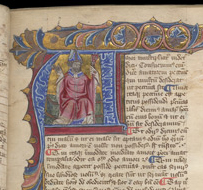
© The British Library Board, Royal MS 6 E V, folio 6r: Initial with Robert Grosseteste as Bishop and Author, opening a copy of his works. Reproduced by permission.
As for access to Western medieval Latin translations and commentaries, there exist ambitious scholarly resources at a price. Notably, the Aristotelis Latinus database comprises “the complete corpus of medieval Latin translations of the works of Aristotle,” by costly subscription. That corpus gathers translations (parts or full) of the Ethica Nicomachea, variously by translators and/or revisers active in the 12th and 13th centuries C.E.
- Burgundius Pisanus (1119? – 1193), as translator Aristotelis (“translator of Aristotle”)
- Guillelmus de Morbeka / Wilhelm von Mörbeke (before 1268 – after 1281), as reuisor translationis Aristotelis secundum exemplar Parisiacum (“reviser of the translation of Aristotle according to the Parisian exemplar”), and
- Robert Grosseteste (circa 1175 –1253), both as reuisor translationis Aristotelis and as translator uel revisor translationis Aristotelis (“translator or reviser of the translation of Aristotle”).
These scholars, translators, and editors emerged from different parts of Europe or the British Isles, as an indication, for example, of the international interest — in Western European terms — of a recovery of the works of Aristotle (and other antique secular texts) in their original language as the dedication to Scholasticism as a form of instruction and an approach to knowledge achieved momentum.
The dedication was non-trivial. For example, Robert Grosseteste’s attention to the text and its improvements fitted within his many contributions overall as statesman, theologian, scientist, scholastic philosopher, and Bishop of Lincoln (from 1235–1281). His imposing “author portrait”, seen here, from a 14th-century copy of some of his sermons and other works (Royal MS 6 E V), sits fittingly at the portal to The Electronic Grosseteste (albeit there cited as “fol. 1ra” in the manuscript).
So far, it appears, the specific translation in the Erfurt manuscript of the Nichomachean Ethics has not been identified.
The Transmission and Dispersal of the Erfurt Manuscript
Given the challenges of dispersal and distribution of the parts of the manuscript mostly without clear and direct trace since its dismemberment by the time it joined Ege’s Portfolios of Famous Books (starting by their first issue in 1923), it is not easy at present to reconstruct the original sequence of its leaves, nor its full original extent. Some of its leaves have come to light, and more may await identification as they have traveled, either separately or in combination. Besides the 2 separate leaves identified in this report, the locations of various of their companions elsewhere in the manuscript have come to light, piecemeal.
[Update: Lisa Fagin Davis reports in the Comments below that more portions, which await processing, appear within The Otto Ege Collection at the Beinecke Rare Book and Manuscript Library of Yale University. Parts of that trove, but not this manuscript, are described and illustrated in our 2016 Symposium on ‘Words & Deeds’ Report.]
Part of that process results from the individual and collective research across the years on the many fragments and residuals of medieval manuscripts which Otto Ege dispersed among different individuals and institutions in his proselytizing activities regarding manuscripts, printed books, and other graphic arts from the 1910s to the time of his death; his widow and other members of his family continued the process in stages. Some links to these continuing contributions in scholarship are listed in our posts on The ‘Foundling Hospital’ for Manuscript Fragments and Lost and Foundlings, in the posts on individual “Ege Manuscripts” listed above, and in the accounts of our 2016 Symposium on Words & Deeds, with its session devoted to the legacy of Otto Ege’s manuscript collection and with its illustrated Program Booklet.
Relevant here as well are some printed works. They include:
1) Judith Oliver, ed.
Manuscripts Sacred and Secular
from the Collections of the Endowment for Biblical Research and Boston University (1985)
2) Christopher de Hamel, Joel Silver, et al.
The Leaf Book Considered (2005)
3) A.S.G. Edwards
‘Otto Ege: The Collector as Destroyer’,
Manuscripta: A Journal for Manuscript Research, 53:1 (2009), 1–12
4) Barbara A Shailor
‘Otto Ege: Portfolios vs. Leaves’,
Manuscripta, 53:1 (2009), 13–27
5) Scott Gwara
Otto Ege’s Manuscripts:
A Study of Ege’s Manuscript Collections, Portfolios, and Retail Trade,
with a Comprehensive Handlist of Manuscripts Collected and Sold (2013),
especially Appendix X: Handlist, No. 41 (pages 132‒133).
Invaluable to the detective work is the ability to observe, either directly or virtually, the appearance and text of individual leaves dispersed in many directions into public or private collections — although sometimes the leaves or sets of leaves have had a tendency to wander further in other directions, sometimes traceable. We work with the materials at hand and in view.
The Erfurt Manuscript and Its Colophon
The Erfurt manuscript as such has the Number 51 (page 136) in the Handlist of Otto Ege’s known Manuscripts assembled by our Associate Scott Gwara for his book on Otto Ege’s Manuscripts (2013).
That brief Handlist description cites the leaf size as 296 × 205 mm <with a written area of 219 × 150 mm>. It reports the layout of the text in double columns variously of 51 to 54 lines.
Gwara’s figure 2 (page 220) reproduces solely the 3-line scribal colophon naming the place and date of production, provided in the form of medieval Arabic numerals. His “List of Illustrations” identifies that image as from a “Private Collection, London” (page 206). As his text explains, the purpose of this figure (and figure 3, likewise cropped, from “Otto Ege Manuscript 52” dated 1456) is to demonstrate that Ege’s dating assessments — sometimes challenged by scholars – could turn out to be “accurate”, as revealed by evidence in the manuscripts themselves (page 6, note 14). [Update: Now that I have seen some of the Residue of the manuscript at the Beinecke, there is cause to wish for an uncropped image of that page with the colophon, not only on general principles — as spelled out in the Research Group’s Style Manfesto — but in particular, because the identity of the “treatises” named in the colophon now requires serious and strenuous re-examination. Hint, Hint.]
In Gwara’s transcription (page 6, note 14), which expands the abbreviations silently, the colophon states:
Expliciunt dicta tractatuum bona et utilia
Erfordie reportata et completa anno domini
1365 proxima feria sequente festum sancti bricii.
“There finish the aforementioned good and useful treatises
brought back to Erfurt and completed in the year of the Lord
1365 on the next week-day following the Feast of Saint Brice.” (Translation mine.)
The feast-day of Saint Bricius, or Brice of Tours (circa 370 – 444 CE), fourth Bishop of Tours in France, falls on 13 November. In 1365, that date occurred on a Thursday.
In contrast to many of Gwara’s 325 Handlist Numbers (pages 116–201), the “Reference” column (column 7) for this manuscript cites as source only the ‘Ege m[icro]f[il]m archive’ — apart from the 2 Leaf Book collections (listed in the Appendixes) in which Ege placed specimens from this book in the form of single leaves, with one leaf from it per Portfolio. Gwara’s Appendixes III and IV (pages 100–102) devoted to those 2 Portfolio collections cite the publication of Christopher de Hamel and Joel Silver (2005) and list some collections where the sets can now be found.
Ege’s Portfolios of Western Medieval Manuscript Leaves
(sometimes combined with other materials)
To recap. Yes, it’s complicated and, yes, it can be confusing.
In the interests of clarity, here is a quick guide to the different portfolio editions by which Ege distributed individual leaves from dismembered Western manuscripts. Some of the Portfolios (or “Leaf Books”) mix such specimens with other types of materials, including Eastern manuscripts and/or printed texts. The mixtures mainly sprinkle a few manuscript leaves, say three, five, or six, with a preponderance of printed leaves. Ege made other portfolios devoted wholly to Eastern manuscripts (Oriental) or to printed texts (demonstrating the evolution of Black Letter Type and Roman Type respectively), as listed in Gwara’s Appendixes V–VII (pages 103–5); their stories deserve other settings.
I. Fifty Medieval Manuscripts in 6 Centuries
Much the most famous, and infamous, following their production and distribution, among Ege’s Portfolio editions is the selection of Fifty Original Leaves from Medieval Manuscripts spanning 6 centuries. Some of our blogposts (see their Contents List) and our 2016 Symposium on Words & Deeds consider that particular set of Portfolios, in the process of identifying and recovering manuscript materials dispersed through them.
Fifty Original Leaves from Medieval Manuscripts, Western Europe, XI–XVI Century [sic]
Edition of 40[+] sets
Issued by Otto F. Ege in 1930–1950
= De Hamel and Silver (2005), Leaf-Book Checklist Number 51 (page 114)
.
Gwara (2013), Appendix VIII (pages 106–107) lists 22 collections with sets in the United States and Japan, plus 3 lost sets.
The contents of this Portfolio span Gwara’s Handlist Numbers 1–50 (pages 116–136); several of these manuscripts (Numbers 5, 9, 33, 39–40, and 49) also appear in some of Ege’s other Portfolios.
II. Famous Bibles in 9 Centuries and 2 Series
One of our blogposts examines dispersed fragments from another manuscript deployed — but not invariably — in a different set, or series of sets, of Ege Portfolios: Ege Manuscript 61, containing parts of a 32-line Latin Vulgate Pocket Bible from France.
Thus we glimpsed Ege’s portfolio editions of Original Leaves from Famous Bibles spanning 9 centuries. The different span of its 2 series represents a shorter and longer view of the genre, governed by substantially different numbers of specimens per series.
- Original Leaves from Famous Bibles, Nine Centuries, 1121–1935 A.D.
Otto F. Ege, Compiler and Editor
This collection appeared in 2 Series, with some overlap between them. - Series A [= Gwara’s ‘FBiblesI’]
Edition of 200 copies with 37 single leaves from different manuscripts or printed books of the Bible
Issued for sale in 1936 by Philip C. Duschnes, Inc., New York
= De Hamel and Silver (2005), Exhibition Number 14 (page 74–75)
and Leaf-Book Checklist Number 68 (page 116)
.
Gwara (2013), Appendix I (pages 95–96) lists 31 collections in the United States and Canada. - Series B [= ‘FBiblesII’]
Edition of 100 copies with 60 single leaves from different manuscripts or printed books of the Bible
Issued for sale in 1938 by Philip C. Duschnes, Inc., New York
= De Hamel and Silver (2005), Leaf-Book Checklist Number 73 (page 117)
.
Gwara (2013), Appendix III (pages 97–77) lists 51 collections in the United States, Canada, and Israel.
The manuscript contents of this Portfolio span Gwara’s Handlist Numbers 56–61 (pages 138–140); 2 of them (Numbers 56 and 59) also appear in some of Ege’s other Portfolios (Oriental and Fifty Original Leaves respectively).
III. Famous Books in 2 or 3 Series
Next in our line of vision are Ege’s portfolio editions of Original Leaves from Famous Books spanning 8 or 9 centuries respectively. The different span represents a Regular and a Deluxe view of the genre. It must be noted that the Regular view had and has a complicated set of variations, as perhaps may the Deluxe view.
Like the other Ege portfolios, the versions of Famous Books comprise boxed sets of individual leaves mounted on mats with descriptive labels printed in black and red. In these cases, they present a few manuscript leaves among the predominantly printed specimens.
One version, spanning 8 centuries with a smaller number of specimens and a larger number of sets, forms the Regular edition. Another, spanning 9 centuries, forms the Deluxe edition.
- Original Leaves from Famous Books, Eight Centuries, 1240 A.D. – 1923 A.D.
Annotated by Otto F. Ege
[= Gwara’s ‘FBEC’]
Regular edition of 110 sets with 1 leaf each from 25 different books
= De Hamel and Silver (2005), Leaf-Book Checklist Numbers 21 and 97
Issued for sale respectively
1) circa 1923 by Otto F. Ege (Cleveland, Ohio) with Portfolio height circa 470 mm
and
2) in 1949 by Philip C. Duschnes (New York, New York) with Portfolio measurements circa 483 × 330 mm
.
Gwara (2013), Appendix III (pages 100–101) lists 22 collections in the United States and Japan, without specifying which issue.
For the second issue he proposes a date instead of circa 1942 (pages 36–37, note 93). - Original Leaves from Famous Books, Nine Centuries, 1122 A.D. – 1923 A.D.
Annotated by Otto F. Ege
[=’FBNC’]
Deluxe edition of 50 sets with 1 leaf each from 40 different books
= De Hamel and Silver (2005), Exhibition Number 20 (pages 79–82)
and Leaf-Book Checklist 98 (page 120)
Issued for sale
in 1949 by Philip C. Duschnes likewise with Portfolio measurements circa 483 × 330 mm
.
Gwara (2013), Appendix IV (page 102) lists 30 collections in the United States and Canada.
The manuscript contents of these Portfolios span Gwara’s Handlist Numbers 51–55 (pages 136–7); one manuscript (Number 53) also appears in another Portfolio (Oriental). Some sets — at Boston University and at Kent State University, as reported by Judith Oliver and by Kathleen Medicus respectively — have a number (see below), like the numbered sets of the Fifty Original Leaves Portfolios. The numbers of the sets of that Portfolio are listed, insofar as they are known or surmised, in the Otto F. Ege Collection website of Denison University and Gwara’s Appendix VIII.
The removal of some sets from their mats (as observed below) may have undermined or eliminated the chance to identify the date(s) of their issue, say by measuring the dimensions of the mat or the box recorded in the Check-List. It seems reasonable to expect that, for the Regular edition, any remaindered sets from the earlier series (1923) may have rolled over into the second series (1949). Without a fuller study (but life is short and other questions press more firmly), it seems unclear to what extent the 2 series blended their components to reach series of equal numbers, or to what extent the 2 Regular series are actually 1. (I predict the latter.)
Which imprecision in the reporting, and perhaps also in the counting, means that the proliferation of the isolated leaves from individual manuscripts (let alone from the printed books) through these portfolio sets in the Regular edition may reach as many as 220 distributed leaves per manuscript, plus the 50 leaves required for the Deluxe edition. Perhaps it is no wonder if substitutions may have had occur between the originally chosen manuscripts and the fulfillment down the line. Let alone between the leaves prepared for selling, replete with mounts, mats, labels, and selling price (or some of those features), and then retained for the “home or family collection” or some other purpose, sometimes with the mat etc. — but not the bits of affixed tape to tell about that changed intention.
To sum up these uncertainties: Who knows how many of the Portfolio-issued leaves are out there, and how many dispersed by other means? As “Rogue Leaves” or “Remnants” as well? [Update: Including, now, the big Remnant(s) transferred to The Otto Ege Collection at Yale, which I have not yet seen. Further Update: Now I have seen at least some of that Remnant, with big surprises, soon to be revealed in another context.] Unless there are other means, such as catalogue or seller’s descriptions, of knowing what number of leaves originally existed in the manuscripts dispersed through the Ege Portfolios (or apart from them), who can say? For some of Ege’s manuscripts, the numbers are known by earlier records. For manuscripts with unnumbered leaves, it’s open season. Happy Hunting!
Contents Lists for the Famous Books
For the Regular Edition spanning Eight Centuries in 25 Specimens, a transcribed Contents List is provided online (not illustrated) for the set now at Purdue University. The full set of the Regular Edition now at Rhodes College in Memphis, Tennessee, is reproduced, with the leaves apart from their Ege/Duschnes mats: Hanson Collection 2 – Pages from Famous Books.
Such varying approaches illustrate the ways in which the information about the different sets of the Portfolio, Regular and Deluxe, in different collections may reveal but also conceal some of the evidence which their set contain(ed). A full study of the surviving parts of the Nichomachean manuscript from Erfurt would have many obstacles to surmount and much distance to travel.
Ege’s “Annotated” Contents List for the Set
The printed Contents List accompanying the Portfolio is informative in several ways, perhaps not all intended. Here is its specimen in Set Number 47 in the Special Collections and Archives of Kent State University.
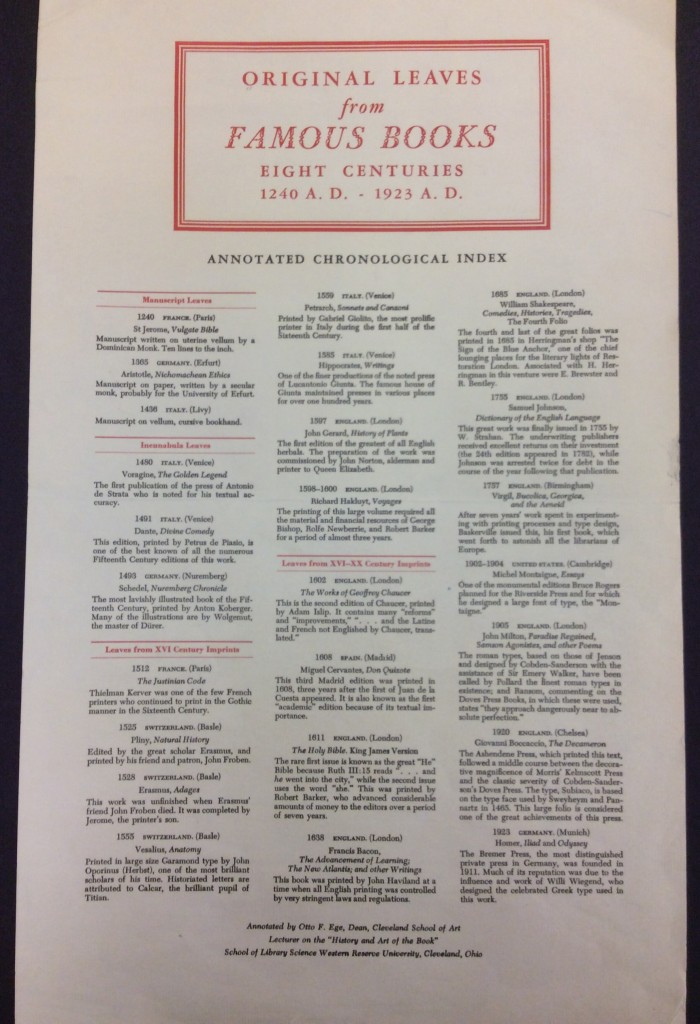
Printed Contents List with ‘Annotations’ by Otto Ege in Set 47 of the Portfolio of ‘Famous Books’. Kent State University Libraries, reproduced by permission.
The heading describes the list as an “Annotated Chronological Index”. The list divides into “Manuscript Leaves” and “Incunable Leaves”, with the latter subdivided into date-ranges for Leaves from “XVI Century Imprints” and “XVII–XX Century Imprints” respectively.
Emphasized in italics, the 3-line footer of the page both names the Annotator and supplies his credentials:
Annotated by Otto F. Ege, Cleveland School of Art
Lecturer on the “History and Art of the Book”
School of Library Science Western Reserve University, Cleveland, Ohio
Aristotle’s Textbook as a Specimen
Now we turn to the Aristotelian manuscript within the Famous Books Portfolios.
In some sets of these Portfolios — I have not made a detailed study of many of them, partly because of not knowing where they or their parts are now or if they have survived — the specimens from this manuscript comprise Leaf 2 (out of the 25 or the 110 specimen leaves, which mostly represent printed texts rather than manuscripts).
Because the Famous Bibles Portfolios, which concentrate upon a particular famous text, demonstrate some variations between the sets (or the series) regarding which manuscript is represented (see our blogpost on ‘Ege Manuscript 61′), it seems reasonable to assume that the Famous Books Portfolio sets/series may exhibit similar variations, that is, until a full study of all the extant copies may demonstrate its particular approaches. Even then, however, the likelihood that not all the original sets have survived, or survived in a recognizable form, may rule out the chance to evaluate the specificity.
So the question of consistency about the positioning of the specimens from Aristotle’s text in the 2 or 3 series (It’s Complicated) of these Portfolios may have to remain open. Inconsistency seems likely, given the distribution within and overlap between other Portfolios.
Looking at Specimens
Some dispersed leaves from the Aristotelian manuscript are reproduced online, either as both sides of the leaf or as one side (that is, as one page, either recto or verso), with or without a mount. For example, both sides of the leaf at Rhodes College are shown with the mount and mounting tapes removed.
(Ege’s caption, illustrated below, is responsible for the portion of the metadata accompanying this pair of images which reports the accompanying “typed description at the bottom of the mat, which reads: ‘Manuscript on paper, written by a secular monk, probably for the University of Erfurt’.” It is worth mentioning that the so-called “typed description” is Ege’s printed slip instead, now that I have seen more of the evidence in other collections, and that it is standard for the specimens in other sets of this Portfolio, rather than, say, the work of a cataloguer on site, as at first I had surmised. See how the descriptions, both by Ege and by others deriving their descriptions from his descriptions, can lead us astray? As they say — OK, I paraphrase, but with a purpose — The Devil Is In The Wrong Details.)
To continue. The search for glimpses of leaves from the manuscript can yield some serendipitous views.
For example, the recto of a leaf now in Brisbane, Australia, appears in the blog by our Associate Lisa Fagin Davis: Manuscript Road Trip: Australian Edition. The framed view of one side of a leaf within Ege’s mat — together with Ege’s rectangular printed label attached to the lower left-hand corner of the windowed mat — appears in another of her posts, showing one cropped (matted) side of the leaf at Samford University in Birmingham, Alabama. According to Gwara’s Appendix III, this set belongs to the Regular edition of the Famous Books.
The Brisbane recto shows a prominent Arabic number 11 written in pencil in forward slanting strokes at the lower right-hand corner; we will call it Pencil Number 11. The mat hides that position on the Birmingham leaf, so we cannot yet say whether it has such a number or not. Revealed in full, the Rhodes College has the Pencil Number 53 at the lower right of the recto. Written by a single modern hand, the Pencil Numbers of this kind on some leaves from the book establish a sequence which might aid a partial reconstruction.
We’ll use any help to hand. Those guides could be far less cumbersome than the laborious method of identifying the sequences of the text, consecutive or otherwise, on identified survivors of the portion with the Dialogues of Gregory the Great in Ege Manuscript 41, aided only occasionally by catchwords ending quires and heralding the next ones.
Two Newly Identified Leaves
 The sight of some other cases, or images thereof, allowed me to identify them as part of the Erfurt manuscript, although I had not considered the manuscript before. Aware of Ege’s characteristic mats and the forms of his printed labels for the various Portfolios, when shown the images, I could recognize at once the resemblance to Ege’s presentation style, as displayed by a leaf which had recently been sold online. A quick check revealed that the leaf had belonged to one of Ege’s manuscripts and to its dispersal in a Portfolio new to me.
The sight of some other cases, or images thereof, allowed me to identify them as part of the Erfurt manuscript, although I had not considered the manuscript before. Aware of Ege’s characteristic mats and the forms of his printed labels for the various Portfolios, when shown the images, I could recognize at once the resemblance to Ege’s presentation style, as displayed by a leaf which had recently been sold online. A quick check revealed that the leaf had belonged to one of Ege’s manuscripts and to its dispersal in a Portfolio new to me.
Another detached leaf (here called the “New Leaf”), which must have been part of the same manuscript, as readily revealed by the similarity of script, scribal hand(s), layout, and text, revealed its presence, although without the customary Ege identifiers. Together, these clues formed the spur for my closer examination of the manuscript, guided and enriched by my individual and collective experiences with other fragments from Ege’s manuscript and printed materials.
Previously my researches regarding isolated leaves handled by Otto Ege involved other Portfolios — first the Fifty Medieval Leaves and next the Famous Bibles, as well as some “Rogue Leaves” or larger Remnants which traveled apart from the Portfolios, often without Ege mats and printed labels, although sometimes with Ege pencil markings. Thus did I encounter (with blogposts issued in this order) the particular challenges of Ege Manuscripts 41, 61, 8, and 14.
The leaves from Ege Manuscript 51 open the path to another of Ege’s Portfolios, the Famous Books. That Portfolio and its several issues possess their own set of complications, as might be expected.
1. Exhibit A: Pencil Number ‘9’
A mounted leaf recently sold online (July 2016) for US $175 by a dealer in Portland, Oregon, indubitably belongs to the former manuscript and to one of the portfolio sets, although unidentified as such by the seller.
His online title introduces the object as “Antique ARISTOTLE Ethics Incunabula Erfurt Germany 1365 AD Manuscript”, with a conflation of terms for manuscript and printed materials (Incunabula). The seller’s photographs helpfully illustrate the front view of the matted unit with its printed label, the back side of the leaf lifted partway on its tape hinges, a full view of the exposed side of the leaf, and a detail of the printed label.
We are told:
Manuscript from Aristotle’s Nicomachean Ethics written in Erfurt Germany in 1365, front and back. Please see last photograph to read details. Overall, very good condition for age, tear at center top center, typical discoloration, slightly attached to card. Actual parchment [sic] measures 9″ x 11 1/2″.
To the informed, the mat and its label are instantly recognizable as one of Ege’s portfolio specimens. As characteristic of some of Ege’s mounted leaves, this arrangement turns the former verso of the leaf to the front. The wirelines of the paper are clearly visible; they seem unusually coarse (like the touch of the Memphis leaf). No parchment in sight.
The blurred ink and the darkened and purplish stains across the top of the leaf, front and back, derive from damp and mold at some stage in the history of the volume, before its dismemberment, as some other leaves share their pattern to greater or lesser extents, and as the mat does not have them. The recto carries the large Pencil Number 9 at the lower right below the text. Some other leaves share this numbering system, with their numbers in the same position, on the recto, or on both recto and verso.
Ege’s Caption for the Specimen
As in other Ege Portfolio series, the Specimen Leaf within its mat is accompanied by a printed slip, attached to the mat at the lower front; in some cases it has come loose, to remain separate or disappear. An example is illustrated from the Famous Bibles Portfolio in the case of ‘Otto Ege Manuscript 61’. The caption describes describes the nature of the specimen, in the style usually of a chatty exhibition caption.
 Ege’s caption, as customary, gives little information about the specimen itself, its script, layout, manuscript setting, and provenance. But something may be better than nothing. After praising “the profound effect on medieval thought” by Aristotle’s works and declaring that “of all these works by one of the world’s greatest thinkers the Nicomachean Ethics has the greatest value to us today and is the most likely [?!] to survive,” Ege summarized the contents:
Ege’s caption, as customary, gives little information about the specimen itself, its script, layout, manuscript setting, and provenance. But something may be better than nothing. After praising “the profound effect on medieval thought” by Aristotle’s works and declaring that “of all these works by one of the world’s greatest thinkers the Nicomachean Ethics has the greatest value to us today and is the most likely [?!] to survive,” Ege summarized the contents:
This masterpiece of Greek literature, named after the son of the philosopher to whom it was dedicated, offers the logical explanation of all aspects of human behavior. In it Aristotle maintains that the chief human good and the end of life is happiness, (well being), and that this consists in virtuous activity, the highest form of which is contemplation.
To round out the caption, Ege mentioned the origin and date of the page (without citing the evidence for it), cited the subsequent foundation of the university at Erfurt and aspects of its curriculum, and offered a few words about the script.
This manuscript page was written in Erfurt, Germany, in the year 1365 A.D., thirteen years before the great university was founded in that small city. This University of Erfurt was the first in Germany to introduce into its curriculum the study of classical literature and the humanities. The casual and natural cursive writing, done hastily, no doubt by a secular writer, is in sharp contrast to the handsome and leisurely executed bookhands we usually find in the work of monastic scribes.
The assumption seems strange that “a secular writer” must “no doubt” have performed this “casual and natural cursive writing,” because “monastic scribes” were mainly responsible for “handsome and leisurely executed bookhands.” Hmm.
Besides those questionable issues about predominantly monastic versus secular tendencies, I wonder whatever might be “natural” about this cursive script, which doubtless had acquired its fluency and speed after very many miles of travel (or practice in accumulated experience). Bet the scribe wasn’t born with it. Born with a propensity or flair for it, maybe, but not for the forms, style, and abbreviations themselves. Nor the need for speed at a particular time and for a specific task.
That disarmingly simple word “natural” inserted into the last sentence of Ege’s Caption to Aristotle and his Ethics-Erfurt-Style gives, upon inspection, a similar frisson to that elicited by a memorable concluding sentence to Vladimir Nabokov‘s chilling Invitation to a Beheading (1935–1936), which considers the bizarrely strange and infrequent likelihood of encountering an “honest bookseller”.
Ege’s Annotation for the Specimen
Ege’s Contents List for the Portfolio summarizes his assessment of the Aristotle Specimen succinctly.
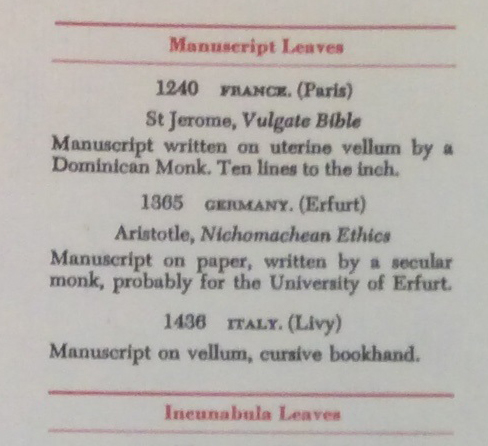
Otto Ege’s ‘Annotation’ for the ‘Manuscript Leaves’ in the Portfolio of ‘Famous Books’. Kent State University Libraries, reproduced by permission.
Listing the leaf first by its date and place of origin, then by its author and text, the Annotation describes it as
Manuscript on paper, written by a secular monk, probably for the University of Erfurt.
Secular monks rule! Especially at a University before the fact. Who knew?
However well-meaning, Ege’s summary Annotation conflates elements of the Caption to produce anachronistic and contradictory claims. Signs of haste appear to be in evidence. Here is another case of bits of information or mis-information leading the Metadata astray, as observed also in other cases of Ege’s captions.
The View from Erfurt
Closer study might reveal where in Erfurt this copy was produced. Before the foundation of the University, we should not rule out either monastic or secular work, pending identification of the scribe’s hand or workshop.
Meanwhile, it is possible to admire the view of the city at a later date, in a skillfully colored woodcut from the illustrated Nurenberg Chronicle, printed in 1493. As a form of world history, including histories of notable cities, the text was composed in Latin by the Nurenberg physician and humanist Hartmann Schedel (1440-1514), with a version in German translation soon by the historian and translator Georg Alt (circa 1450 – 1510), also printed in 1493. Both these editions were extensively illustrated with 1804 xylographical images, hand-colored in some copies, prepared from woodblocks by the Nurenberg artists Michael Wolgemut (circa 1434/37 – 1519) and Wilhelm Pleydenwurff (circa 1450 – 1494), as well as maps of the World and of Northern Europe. Lots to admire.
View of Erfurt. Colored woodcut from the ‘Nurenberg Chronicle’ by Hartmann Schedel (1493). Via Wikipedia Commons.
Copies of the Nurenberg Chronicle can be viewed online, whereby the view of Erfurt stands within the pages of the book. The digital facsimiles include the hand-colored copy donated to the University of Cambridge in 1574, along with 75 early printed books and 25 manuscripts, by the scholar and bibliophile Matthew Parker (1504–75), archbishop of Canterbury. I have had cause to become familiar with his collection of books and manuscripts — now dispersed in various collections — as demonstrated, for example, in the Illustrated Catalogue (for which the Research Group, its co-publisher, now has a special Promotional Offer).
Originally the University of Erfurt, founded in 1379, centered its instruction in the Latin Quarter of the city, around the Michaeliskirche, which served as the University Church. The Church of Saint Michael appears as Number 17, located nearly at the top to right of center, in the copper engraving of a bird’s eye-view of the city by Matthäus Merian the Elder (1593–1650) for the 16-volumne Topographia superioris Saxoniae . . . (1650).
The university was closed in 1816, when the city became part of Prussia, but it reopened in 1993. Students of its original foundation included the theologian Martin Luther (1483–1546) and (apparently) the printer Johannes Gutenberg (circa 1398 – 1468). It is worth wondering what tasks of procuring, assembling, and (re)producing copies of textbooks may have accompanied the preparations for founding the university, which achieved its results only a decade or so after the text of Aristotle’s Nichomachean Ethics (in Latin translation anyway) reached the copyist of Ege’s Erfurt manuscript in time for its completion by November 1365 .

View of Erfurt in engraving by Matthäus Merian the Elder in the ‘Topographia Superioris Saxoniae’ (1650) via Wikipedia Commons.
2. Exhibit B: Pencil Number ’96’
Another leaf from the same Aristotelian book belongs to a private collection. Shown here, it was purchased on its own, without any mat, from a booksale at the University of Michigan Library in 1999 or 2000 for about $25. I’ll call it the New Leaf. Its Pencil Number is 96.
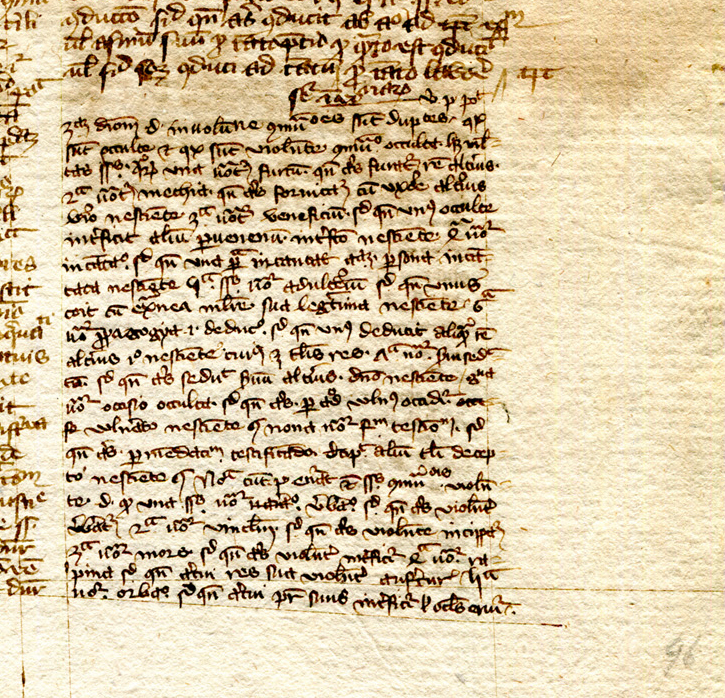 Like other observable leaves of the text, the columns indent nearly half a line for 2 consecutive lines (or sometimes 1 line only) to allow for the subsequent entry of the first word(s) opening a new section. Like some other leaves, those gaps remain unfilled, still awaiting the insertion of the opening elements intended, apparently, in a different form, coloring, grade of script, and perhaps some modest decoration. The recto of the Oregon Leaf (“Exhibit A”) carries one filled element (Commune est) in larger script and thinner ink.
Like other observable leaves of the text, the columns indent nearly half a line for 2 consecutive lines (or sometimes 1 line only) to allow for the subsequent entry of the first word(s) opening a new section. Like some other leaves, those gaps remain unfilled, still awaiting the insertion of the opening elements intended, apparently, in a different form, coloring, grade of script, and perhaps some modest decoration. The recto of the Oregon Leaf (“Exhibit A”) carries one filled element (Commune est) in larger script and thinner ink.
The text is written in Gothic cursive script, with rapid strokes and many abbreviations, packing the text densely onto the pages. The skilled script exhibits some signs of haste in the transcription, as omissions find some supplied insertions in the margin (as on the New Leaf recto, column b, signalled by a long caret-shaped sign both before the insertion and within the line, marking the place where it is to be understood as supplied. Some lines of script are decidedly askew, not only where the ruling or extra ruling directed it this (as at the bottom of that same column).
Recto
 Verso
Verso
The variable number of lines per page can also extend to the columns of a single page. The recto of the New Leaf has 52 lines per column, within Gwara’s cited range of “51–54 lines” (see above). On the verso, column a has 51 lines, while column b has 50, as an indentation for the opening letters of a new section skips only 1 line, but the reversion to the full width in the next line first behaves as if 2 lines had been skipped, but then rises unsteadily to try to maintain a closer distance with the preceding line, that is, the first indented line, more like the standard. As reported by Oliver (1985), number 112 (page 79), the Boston University leaf has “46 lines”. Variations may perhaps be expected on other leaves as well.
The New Leaf possesses a simple, stylized manicula (“little hand”), drawn in the intercolumn to point toward the section which opens in line b36 with a Paraph-mark. Such maniculae, added by many scribes or readers in the late medieval and early modern periods, provide clear signals toward passages worthy of note (for whatever reason or reasons). These markers occur in many locations and many styles, some idiosyncratic and some identifiable as the work of a given hand. (The form by Matthew Parker, for example, is one such case.) This case of a pointer resembles a long pointing finger which ascends diagonally from a more-or-less horizontal cuff to a pointed tip aimed at the Paraph in question.
The Watermark
The New Leaf possesses a watermark. To put it purely and simply, its form belongs to a known watermark, as identified by Briquet and classified under the category of Crosse. (See below.)
First the watermark, then the data. First the Briquet diagram, then the watermark on the leaf, seen with back-lighting. Then the data.
Its Identification
The evidence of watermarks in paper comprises a vast subject. Some Sessions sponsored by the Research Group on Manuscript Evidence over the years have considered some of their issues pertaining to specific cases. Some of our other projects also engage with such challenges. Because the watermark on the New Leaf corresponds with an already classified case, we may focus on that material.
Consider the source. The watermark appears as an item or entry in the monumental, pioneering 4-volume publication by the Swiss filigranologist Charles-Moïse Briquet (1839–1918): Les Filigranes. Dictionnaire historique des marques du papier, dès leur apparition vers 1282 jusqu’en 1600, avec 39 figures dans le texte et 16 112 fac-similés de filigranes (Geneva, 1907). Astonishing in their scope, don’t you think, to encompass more than 16,000 watermarks? Examine examples, look for dated cases, e voilà!
About the importance of this bibliographical resource, see, for example, its description in the Gravell Watermark Archive. Did we mention that it is cumbersome to consult? Fortunately, it is now available partly online: Briquet Online Volume 1 (parts). Fortunately, for present purposes, those parts include one of interest here.
The Crook in the Tale
The watermark on the New Leaf comprises a fairly simple, upright crook or crozier. Its specific representative in Briquet’s Dictionnaire historique of watermarks appears as one of the specimens under the classification of Crosse (French for “shepherd’s staff”, “crook”, or “crozier”): Briquet Number 5762, citing a dated example of 1369 CE. Taken together, the case of the New Leaf and the colophon of its manuscript permits an earlier dating of the use of this paper stock by 4 years. [Update: My recent glimpses of the Residue of the manuscript at the Beinecke Library reveal that I will have to revise or confirm this dating after further research on the newly revealed portions, some with watermarks. So please watch this space.]
The crook or crozier takes the form of a hook curled through nearly one complete revolution to a bulb-like terminal, with a stubby “hilt” or stopper below the angular turn at the base of the curl. Because such a form would not serve a shepherd’s purpose in the field for catch and release of a sheep’s extremities, we ought not think of it as denoting a shepherd’s staff or crook, but as a cozier of some sort. Staff of office.
Perhaps it is known, but not by me, where this paper was produced, nor how far extended its distribution and use. We don’t even know if the full Aristotelian manuscript used only this paper, but mixed other stock with it. Examples of late medieval northern European manuscripts which combine different types of paper, let alone parchment as well, form the subject of one of my recent papers for a session sponsored by the Research Group on Manuscript Evidence. Have a look: Double Act: Manuscripts Combining Paper and Parchment.
Watermarks and Pencil Numbers on Other Leaves
So far, I know of one other leaf with a watermark from the Erfurt manuscript. Our Associate Judith Oliver’s catalogue entry for the leaf from the same manuscript now at Boston University — Oliver (1985), number 112 (page 79), without an illustration — reports its “Watermark: key(?).” That form is possibly the same “Crosse.”
Oliver’s description of the Boston leaf establishes that it comes from Set number “54 of 110” of the Regular edition of Famous Books: see her numbers 30 and 112 (pages 16–17 and 79). She also records the presence on the leaf of a “penciled number 87”, presumably in the form and location which we would call Pencil Number 87.
Insufficient evidence comes to hand to determine the specific significance of the Pencil Numbers in the lower right-hand corners of some leaves. They appear either on the rectos or on both rectos and versos. The duplication of the same number on both sides of a leaf presumably rules out its function as a page number (which would pertain to one side only). So far I know of Numbers 9 (the Oregon leaf), 11 (the Brisbane leaf), 53 (the Memphis leaf), 87 (the Boston leaf), and 96 (the “New Leaf”). A consecutive sequence of some length is implied, of a span as yet unascertained. We may be entitled to consider that, without examining their texts themselves, these leaves fall into that numerical sequence in the original manuscript, gaps included.
That not all the leaves whose relevant locations are visible to me possess such numbers suggests that these numbers do not function as page- or folio-numbers, unless we posit a variable or inconsistent numbering for those elements. (Not impossible, just hard to fathom.)
Perhaps the numbers designate the start of quires, in the way that some modern cataloguers of manuscripts might place a pencil number at the front of such a unit. Such practice, with a discreet pencil number at the top left of the first leaf of a quire, was adopted by M. R. James in his work of cataloguing the manuscript collections of numerous libraries in England. My Illustrated Catalogue reports those entries in manuscripts at Corpus Christi College, Cambridge; these elements can now be viewed online.
Other intentions may be relevant, such as the designation of sections of leaves for distribution among the sets of the Portfolios or elsewhere. Further cases among the surviving leaves of the manuscript could reveal the purpose of these markers.
Update: Leaf ’19’ numbered in Both Pencil and Ink,
All in Modern Arabic Numerals
After the publication of this blogpost, I have been able to see images from the Leaf in Set numbered 47 in the Kent State University Libraries Special Collections. Naturally — we are in the realm of manuscripts, after all — it shows some things that the other leaves which, so far, I have been able to see or to glimpse from afar do not. (Or which I do not yet have the awareness to recognize.)
Here are both sides. (It might always be useful to see both sides of an issue, or a leaf.)
Recto first. Note the Pencil Number 19. And the Ink Number ’19.’ in the top right corner.
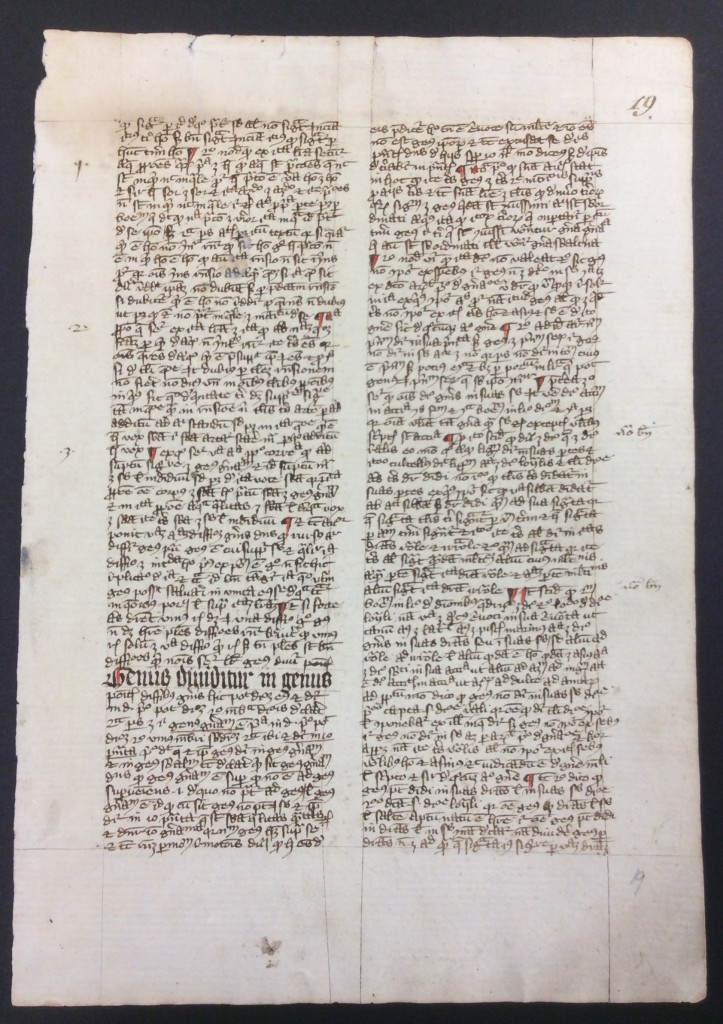
Recto of Aristotle Leaf in Set 47 of the Portfolio of ‘Famous Books’. Kent State University Libraries, reproduced by permission.
Now the verso.

Verso of Aristotle Leaf in Set 47 of the Portfolio of ‘Famous Books’. Kent State University Libraries, reproduced by permission.
A few elements to note as we begin to ruminate on the information which this leaf conveys. Two section titles, one per side, written in Gothic Textura script, fill the single lines presumably left wholly blank to receive them — in contrast to the practice of indenting only part of a line on other revealed leaves. They proclaim: Genus subalternum est in line 42 of column b on the recto (= line rb42) and Genus dividitur in genus in line va41.
Here, the Paraph marks and some of the subsections contain a wash of red pigment, contrasting with the black ink of the text and the section titles. The initial Gs of those titles likewise carry a vertical stroke of red pigment. The bichrome elements function as a form of highlighting to ease the burden of recognizing sections within the dense columns of compacted, abbreviated script in mostly unrelieved long lines.
The text in double columns extends for 53 lines in both columns on the recto. On the verso it extends for 54 lines in column a and, with a cramped extra line below the ruled column, 55 lines in column b. Written in ink in the margin to the left of column ra, and flanked by dots (medieval style), the arabic numbers 1, 2, and 3 mark passages for consideration. Such signs of consultation and, perhaps, the several stains on the paper, as well as other signs of wear, attest in mostly mute ways to the use or intended use of the manuscript once it had been copied.
[Update to the Update:
With the appearance of the Kent State University Leaf in this updated post, our Associate Linde M. Brocato, returning to the Rhodes College Leaf in Memphis and joining our quest, makes these observations:
That the Kent State leaf is rubricated and has its textualis header, and that it has Pencil Number 9, suggests that the number may be a leaf number or at least indicate a position nearer the beginning of the text, such that this second pass of reading and rubricating (and correcting?) got that far. That the header is the full width of the column in the Kent State leaf, and not the full width on the Rhodes and other leaves may suggest a space-saving move. Whoever is copying this has a fair enough scholar’s hand but is clearly not a scribe or notary, even if very familiar and comfortable with the norms of textual parsing (reading and inscribing them).
Thank you, Linde!]
Now that the presence of an Ink Number has emerged into view, moreover corresponding numerically to the Pencil Number at the foot of the page, that “new” number — or new to us, anyway — requires us to wonder about its sequence and what its other members on other leaves (as yet unglimpsed) might reveal. Its style of script accords with a somewhat earlier, but still modern, date, say 19th-century.
To update the known sequence: Numbers 9 (the Oregon leaf), 11 (the Brisbane leaf), 19 (the Kent State University leaf), 53 (the Memphis leaf), 87 (the Boston leaf), and 96 (the “New Leaf”). So far they represent discontinuous, rather than continuous, portions of Aristotle’s text — in contrast, for example, to the conjectured reconstruction which I have been able to make able to detect for parts of the Dialogues by Gregory the Great from ‘Otto Ege Manuscript 41’, the first of the dispersed ‘Ege Manuscripts’ examined in detail in my blogposts on Manuscript Studies.
Watch this space! Do you think that this research work sounds like detective work? And that the clues come to light in stages, not necessary in any special order, except that the order in which they appear is special, uniquely its own? Yes, you get the picture.
Just call us Doctor Who-Done-It. (Wouldn’t be the first time, in fact.) We might well answer.
Round Up
The newly identified leaves and their several companions surveyed in this report may illuminate the context in which they stood in their former manuscript. More remains to be discovered.
Their ensemble in the former volume attests to the determination to procure and to produce a copy of Aristotle’s Nichomachean Ethics in textbook form, with rapid cursive script and multiple abbreviations, at Erfurt by mid-November 1365. Their transmission in pieces in the 20th century from Cleveland and New York to a multiplicity of centers attests to the determination to procure, to dismember, and to distribute specimens of medieval manuscript production among other specimens of texts in print across multiple centuries.
While many other manuscripts from Ege’s collection receive greater attention, for example for their decoration, illustration, music, or other distinctive features (such as the Beauvais Missal, the Wilton Processional, or the monumental Lectern Bible used by Dominicans) and through their association within Ege’s other Portfolios receiving concerted research (the Fifty Original Leaves especially), this relatively “simple” Aristotelian textbook may stand as a representative of the poignant fate of many medieval (or other) manuscripts in the modern period.
Otto Ege’s evaluation of this specimen from Erfurt asserts that “of all these works by one of the greatest thinkers the Nichomachean Ethics has the greatest value to us today and is the most likely to survive [emphasis mine].” Ironic that the survival pattern of this very copy took a sharp turn as the book was decisively, deliberately, and irrevocably, transformed into the predicament of separated and scattered fragments. The additions of enclosures in the form of windowed mats and the attachments of printed labels describing the genre of the former book gave some enveloping covers and appendages which provide certain modes of distinction. The company of the other matted specimens in the Portfolio of Famous Books, including a few manuscripts and many more printed materials, gave a veneer of similarity overall to the different collected items.
Flying Solo
The temptation, in turn, to remove the specimens from their mats (as in some collections to which the Portfolio sets have arrived) or to remove individual matted leaves from each other and from the set of Portfolio as a whole (as apparently the case with the Oregon leaf) seems to be an ineluctable extension of the transmission pattern once the fragmentation and dispersal had begun.
That some leaves from the fragmented Erfurt manuscript seem to have traveled without mats at all — or with the mat having been removed sometime or other, but leaving the traces of its mounting tape upon the surface of one side of the leaf, as apparently the case with the New Leaf — can mean that this book, too, found its dispersal in part through the Portfolio series of one kind or another and in part by other methods. That duality of modes of dispersal is known for some other Ege manuscripts.
A case in point is the New Leaf from Otto Ege Manuscript 14, purchased on its own at the Cleveland Museum of Art in August 1953. It carries Ege’s pencil inscription across the bottom of the recto, with a description of the contents and the price. A set of Inventory/Sales Records of 1956 in Mrs. Ege’s hand, partly illustrated in Gwara (2013), Figures 1a–g (pages 214–220), shows the sales of various bits from numerous books, in whatever state of presentation. Tip of the Iceberg.
Flying in Formation
Once the process of fragmentation and dispersal of the monument begins, the sets of skills required for detecting, identifying, and tracking its evidence perforce extend beyond the many skills already demanded for observing, recording, and analyzing the body of material and setting it in context. It is necessary to work with the materials available, and to search for more, or more traces of their original whole. Integrating these aspects, however incomplete, may illuminate features cast into darkness or obscurity. Survival of sorts.
Do you know of other leaves from this manuscript? Or the scribe’s work in other manuscripts? Or the use of this paper with its particular crook-shaped watermark in other places, textbooks or elsewhere? Please let us know.
*****
Team Work, With Thanks
We thank the Owner of the New Leaf for permission to examine, photograph, and publish the original. We thank colleagues, including Lisa Fagin Davis, Linde Brocato, Scott Gwara, Roger Wieck, and others. We thank the librarians and staff of different collections for access to materials and for responses to queries about them. The list to thank happily grows.
To begin : Kent State University University Libraries (special thanks to Amanda Faehnel!), Rhodes College, the Morgan Museum and Library, and the Beinecke Rare Book and Manuscript Library (special thanks to Raymond Clemens, Diane Ducharme, and Barbara Shailor!). There is more to report, as the research discoveries extend. Please join the conversation, and, if you like, the detective work!
*****

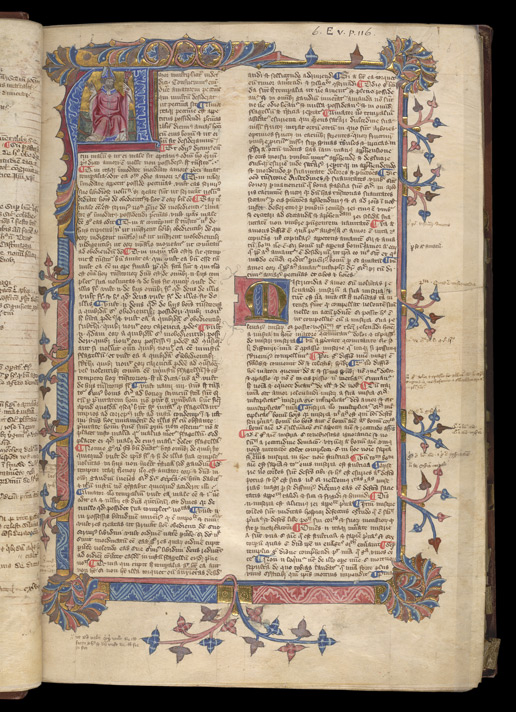
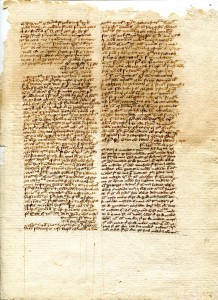
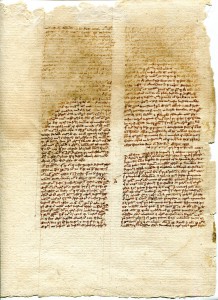

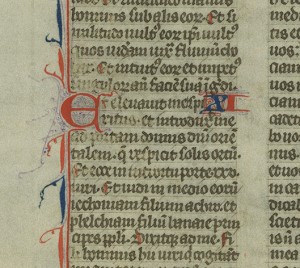
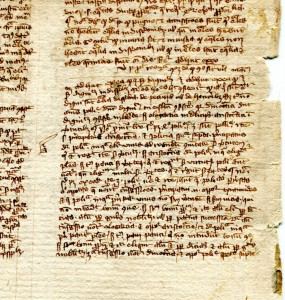
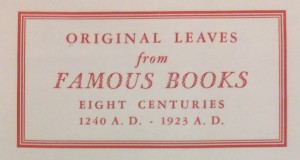
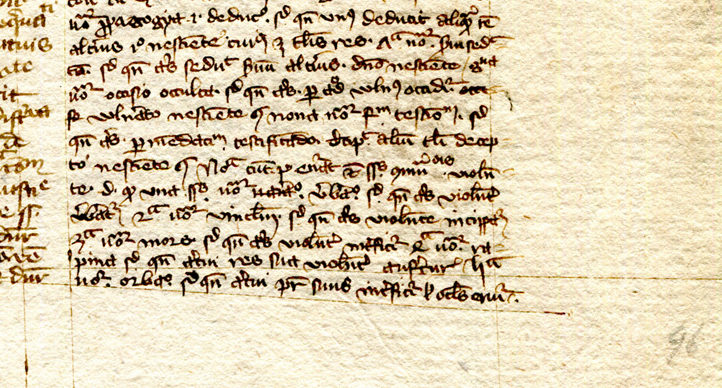


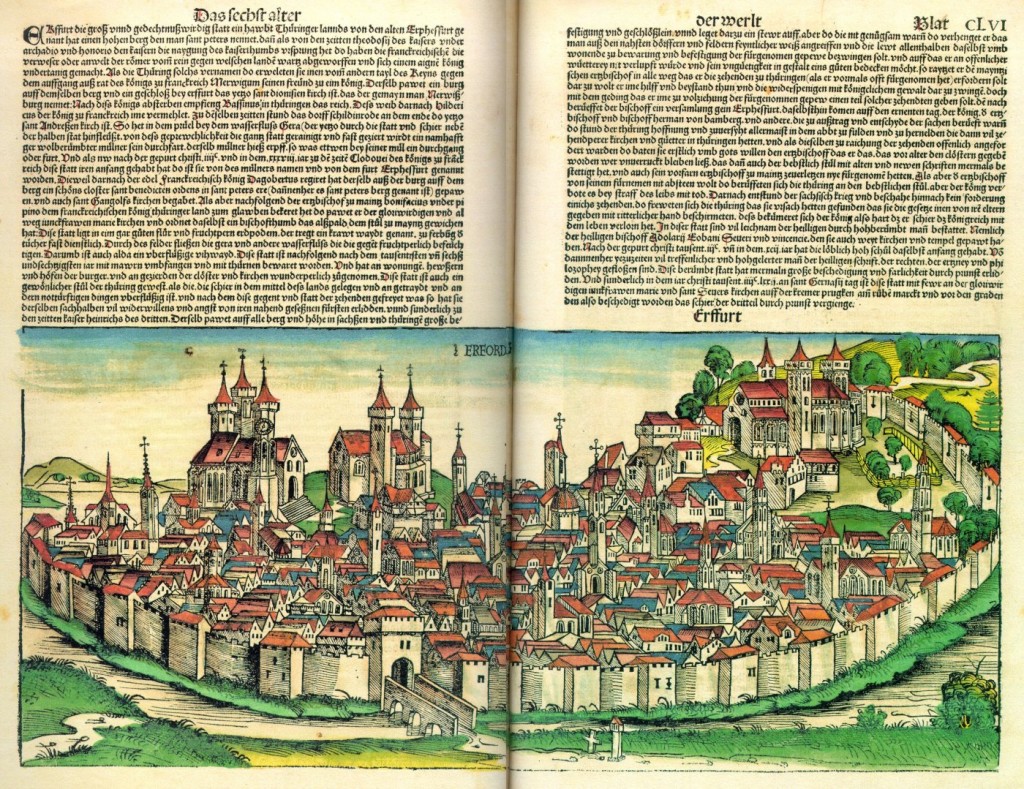
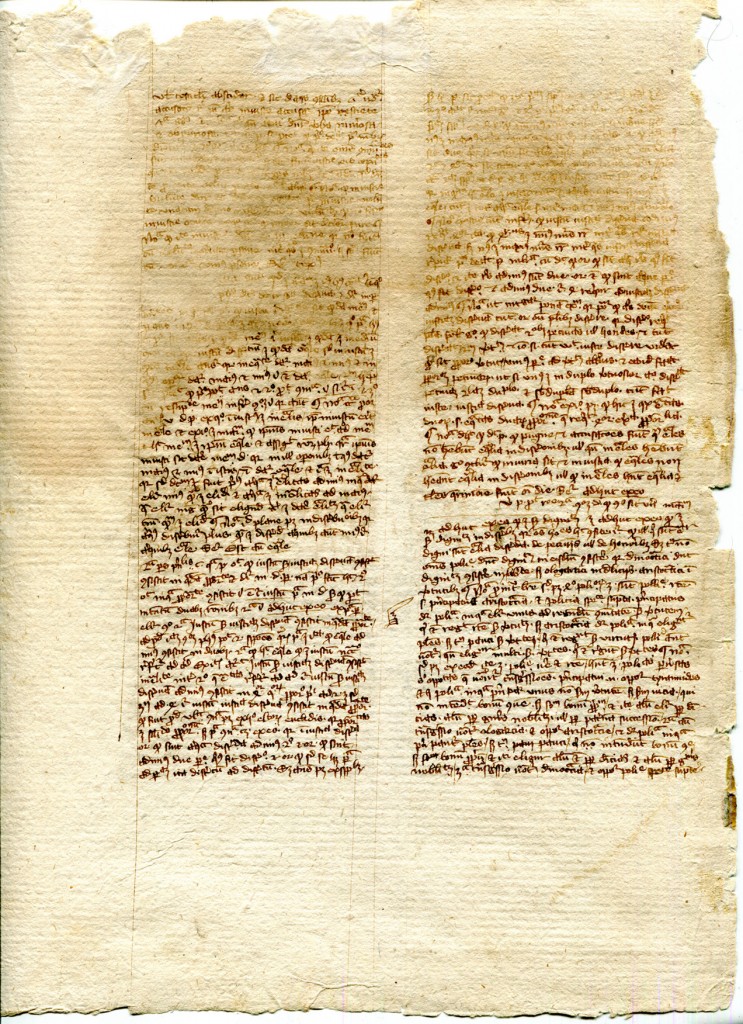

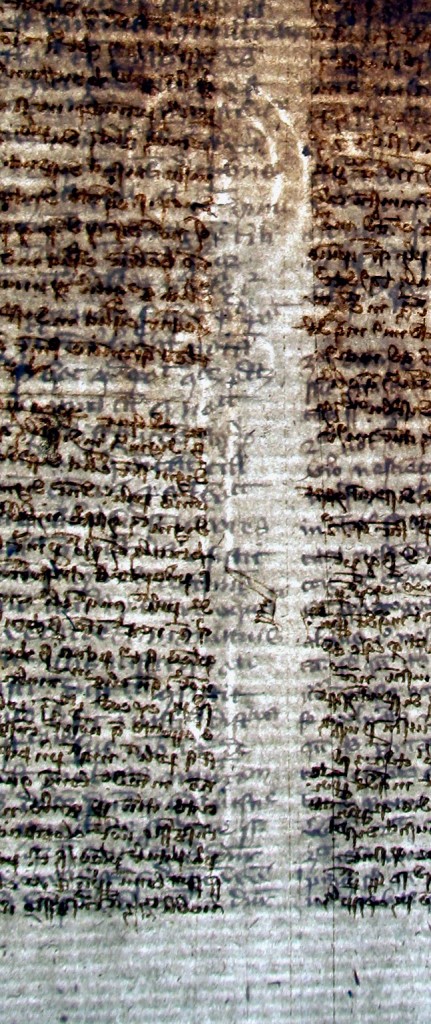
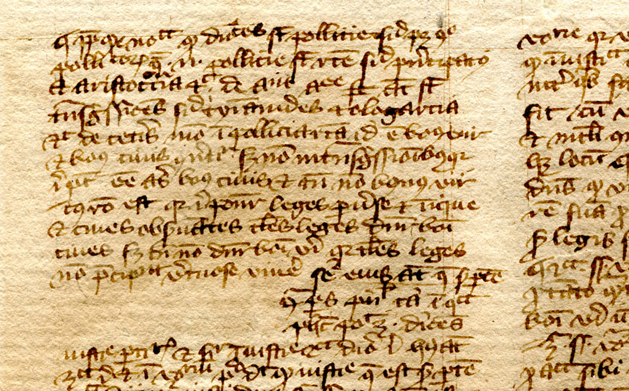
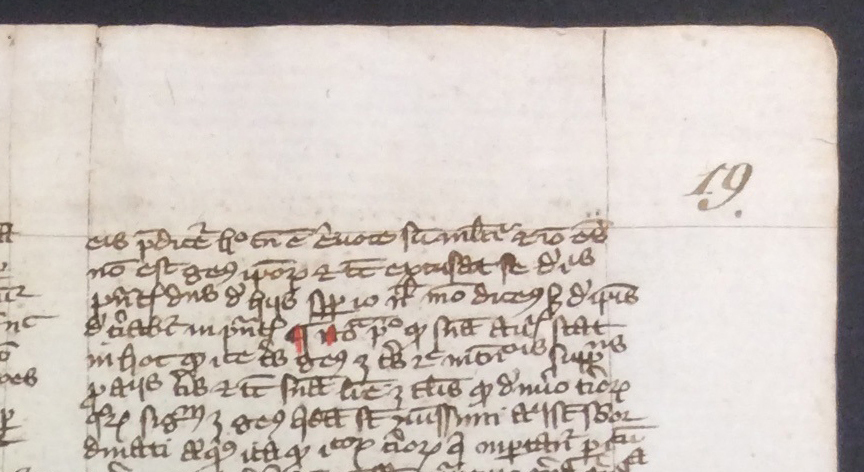

Hi, Milly,Congratulations on this amazing piece of work! There are DOZENS of leaves of the Erfurt ms in the new Ege collection at Yale, which is still being processed and isn’t yet open for research. But once it’s made available, you’ll definitely want to take a look, as the collection includes not only the leaves but the original binding! – Lisa
Hi Lisa,
Thank you for your praise, which means a great deal to me as a strong admirer of your own manuscript researches.
It’s fantastic to learn about the trove of leaves, plus the original binding (hurray!), at the new Otto Ege Collection at the Beinecke. Your news is very helpful!
All best,
Milly
Your research on the Erfurt ms. is truly wonderful; enjoyed it so much – and it’s wonderful to show our students how research on the Otto Ege leaves may lead to such wonderful discoveries. Loyola Marymount University’s leaf from the ms. is here: https://digitalcollections.lmu.edu/Documents/Detail/aristotle-ethics-1365/12208 ; loved seeing images of other leaves from the same book. Thank you.